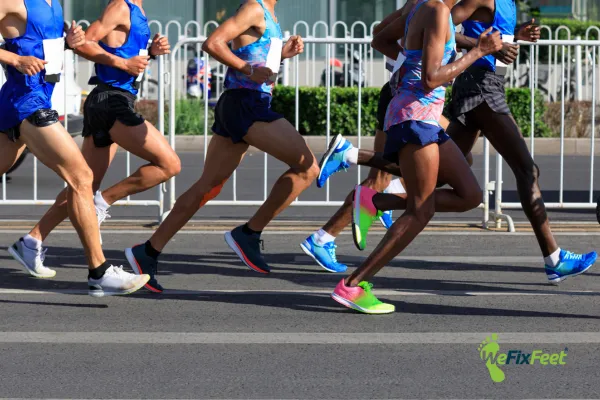
Strength Training for Runners: The Secret to Injury-Free RunningStrength Training for Runners: The Secret to Injury-Free Running
Introduction: Why Runners Need Strength Training
Many runners believe that the best way to improve their performance is simply by running more. But what if lifting weights could make you a better, faster, and more injury-resistant runner?
Strength training isn’t just for bodybuilders or sprinters—it can also be a game-changer for endurance runners. Incorporating strength work into training can help prevent injuries, improve efficiency, and speed recovery.
This guide will explore why runners should lift weights, the best exercises for running performance, and how to balance strength training with your running routine.
Why Strength Training Is Essential for Runners
1. Reduces Injury Risk
Running is a high-impact, repetitive motion, leading to overuse injuries like shin splints, Achilles tendinitis, IT band syndrome, and a runner’s knee. Strength training helps by:
✅ Improving muscle imbalances – Stronger muscles correct weaknesses that lead to poor form.
✅ Enhancing joint stability – Prevents knee, ankle, and hip injuries.
✅ Strengthening tendons and ligaments – Reduces stress on joints and tissues.
2. Improves Running Economy
Running economy refers to how efficiently your body uses oxygen while running. Strength training improves this by:
✅ Increasing neuromuscular coordination – Your muscles learn to work together more efficiently.
✅ Boosting power and stride efficiency – Stronger legs create a more powerful push-off with each step.
✅ Reducing energy waste – A well-conditioned body moves with less effort.
3. Helps You Run Faster
Strength training builds explosive power, allowing you to maintain speed and endurance.
✅ Stronger glutes and hamstrings = More propulsion per stride.
✅ Better core stability = Improved posture and running mechanics.
✅ Increased stride efficiency = Less energy wasted with each step.
4. Speeds Up Recovery
When muscles are strong, they absorb more impact, reducing stress on bones and joints. This leads to:
✅ Faster post-run recovery – Less soreness and stiffness.
✅ Lower risk of stress fractures – Bones become denser with weight training.
✅ Improved circulation – Strength work increases blood flow, aiding recovery.
The Best Strength Training Exercises for Runners
An effective strength routine for runners should focus on core stability, lower body strength, and injury prevention.
1. Lower Body Strength
✅ Squats – Strengthens quads, glutes, and hamstrings for powerful strides.
✅ Lunges – Improves balance and single-leg strength, reducing knee strain.
✅ Deadlifts – Builds posterior chain strength, crucial for endurance and injury prevention. ✅ Calf Raises – Strengthens the calves and Achilles tendon to prevent overuse injuries.
2. Core Stability
A strong core stabilises the entire body during running.
✅ Planks – Improves overall core strength and posture.
✅ Russian Twists – Enhances rotational strength and balance.
✅ Hanging Knee Raises – Targets lower abs and hip flexors for better running form.
3. Hip and Glute Activation
Weak hips and glutes lead to poor running form and knee injuries.
✅ Glute Bridges – Activates the glutes, essential for propulsion.
✅ Clamshells – Strengthens the glute medius to reduce IT band issues.
✅ Side Leg Raises – Improves lateral stability and prevents hip injuries.
4. Upper Body Strength
While running is lower-body dominant, a strong upper body improves posture and endurance.
✅ Push-ups – Strengthens chest, shoulders, and arms.
✅ Bent-over Rows – Improves back strength and posture.
✅ Overhead Press – Enhances shoulder stability for better running form.
How to Integrate Strength Training into Your Running Routine
You don’t need to lift heavy weights every day to see benefits. 2-3 weekly sessions are enough to build strength while maintaining running performance.
Sample Weekly Plan:
🏃 Monday: Easy run + Strength session (lower body focus)
🏋️ Tuesday: Cross-training or rest
🏃 Wednesday: Interval run + Core & Glutes strength session
🏋️ Thursday: Strength session (upper body focus) or yoga
🏃 Friday: Easy run + mobility work
🏃 Saturday: Long run
🚶 Sunday: Rest or light recovery walk
Common Strength Training Mistakes Runners Should Avoid
🚫 Skipping Strength Work Entirely – Running alone doesn’t build the muscular resilience needed to avoid injury.
🚫 Doing Too Much Too Soon – Introduce weight training gradually to avoid overtraining. 🚫 Neglecting Recovery – Strength work stresses muscles—stretch, foam roll, and rest properly.
🚫 Lifting Too Heavy Without Proper Form – Poor technique can lead to injury rather than prevention.
Final Thoughts: Stronger Muscles, Stronger Running
Strength training isn’t just a supplement to running—it’s necessary for runners who want to stay injury-free, improve performance, and recover faster.
By incorporating a structured strength program focusing on lower body, core, and mobility work, runners can build resilience, enhance efficiency, and run pain-free for years.
🚨 Don’t wait until you’re injured—start strength training today and feel the difference in your running!
Ask The We Fix Feet Team
Fill in the form to request a Call From Our Team
One of our team will call you for FREE and answer any questions or concerns you may have about your uncomfortable foot condition

Where To Find We Fix Feet
Our We Fix Feet podiatry clinics are conveniently located in Ilkeston, Derbyshire and Beeston, Nottinghamshire
Open: Mon-Fri 09:00-17:00 / Sat 09:00-13:00
94 Bath Street, Ilkeston, Derbyshire DE7 8FE
8 Wollaton Road, Beeston, Nottinghamshire NG9 2NR
Pay and display parking nearby




